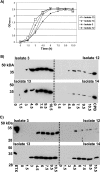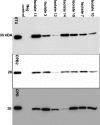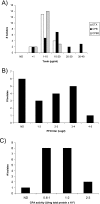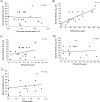Both epsilon-toxin and beta-toxin are important for the lethal properties of Clostridium perfringens type B isolates in the mouse intravenous injection model
- PMID: 17210666
- PMCID: PMC1828578
- DOI: 10.1128/IAI.01672-06
Both epsilon-toxin and beta-toxin are important for the lethal properties of Clostridium perfringens type B isolates in the mouse intravenous injection model
Abstract
Clostridium perfringens is capable of producing up to 15 toxins, including alpha-toxin (CPA), beta-toxin (CPB), epsilon-toxin (ETX), enterotoxin, beta2-toxin (CPB2), and perfringolysin O. Type B isolates, which must produce CPA, CPB, and ETX, are associated with animal illnesses characterized by sudden death or acute neurological signs, with or without intestinal damage. Type B pathogenesis in ruminants is poorly understood, with some animals showing lesions and clinical signs similar to those caused by either type C or type D infections. It is unknown whether host or environmental conditions are dominant for determining the outcome of type B disease or if disease outcomes are determined by variable characteristics of type B isolates. To help clarify this issue, 19 type B isolates were evaluated for toxin production during late-log-phase growth via quantitative Western blotting and by biological activity assays. Most type B isolates produced CPB levels similar to those produced by type C isolates in vitro and have the potential to produce genotype C-like disease. The lethality of type B isolate supernatants administered intravenously to mice was evaluated with or without prior trypsin treatment, and monoclonal antibody neutralization studies also were performed. Correlation analyses comparing toxin levels in type B supernatants versus lethality and neutralization studies both found that the main contributor to lethality without pretreatment with trypsin was CPB, whereas neutralization studies indicated that CPB and ETX were both important after trypsin pretreatment. At least part of the CPB produced by type B isolates remained active after trypsin treatment. However, the overall lethalities of most supernatants were lower after trypsin pretreatment. Also, there was a significant association between ETX, CPB2, and CPA production in vitro among type B isolates. However, our results suggest that both CPB and ETX are likely the most important contributors to the pathogenesis of C. perfringens type B infections in domestic animals.
Figures







References
-
- Al-Sheikhly, F., and R. B. Truscott. 1977. The pathology of necrotic enteritis of chickens following infusion of crude toxins of Clostridium perfringens into the duodenum. Avian Dis. 21:241-255. - PubMed
-
- Barker, I. K., A. A. Van Dreumel, and N. Palmer. 1993. The alimentary system, p. 237-247. In K. V. F. Jubb, P. C. Kennedy, and N. Palmer (ed.), Pathology of domestic animals, 4th ed. Academic Press, New York, NY.
-
- Bruce, R. D. 1985. An up-and-down procedure for acute toxicity testing. Fundam. Appl. Toxicol. 5:151-157. - PubMed
-
- Bueschel, D. M., B. H. Jost, S. J. Billington, H. T. Trinh, and J. G. Songer. 2003. Prevalence of cpb2, encoding beta2 toxin, in Clostridium perfringens field isolates: correlation of genotype with phenotype. Vet. Microbiol. 94:121-129. - PubMed
Publication types
MeSH terms
Substances
Associated data
- Actions
- Actions
- Actions
Grants and funding
LinkOut - more resources
Full Text Sources
Miscellaneous

